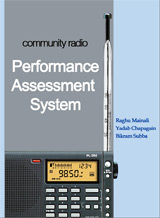UNESCO-supported Nepali NGO launches a set of indicators on community media
16-09-2009 (Kathmandu)

Publication cover
© CRSC
The Nepali Community Radio Support Centre (CRSC) has recently launched a new manual entitled Community Radio Performance Assessment System. This most comprehensive set of indicators concerning community media is the result of a decade-long work of CRSC in promoting, enabling and facilitating the community radio movement in Nepal.
“The one who speaks can market even the flour successfully while the one who cannot do so cannot even market the rice,” says a Nepali proverb. This highlights the importance of effective communication. Radio happens to be the most effective way of communication in the country, where the majority of population lives in villages and the half of it cannot read and write. The Nepal experience of community radio is fascinating, inspiring and full of lessons to be learned. But the huge proliferation of community radios there urgently requires well-considered benchmarks and criteria. The new CRSC manual is a major contribution to the development of community media not just in Nepal but more widely in South Asia and internationally.
Community Radio Performance Assessment System draws effectively from both the grassroots experience of community media and from international broadcast practices. It considers the issues that are the real basis for the success of community media: public accountability, community representation, locally relevant programming, diverse funding and acknowledgement of staff, including volunteers.
The manual contains a great amount of knowledge concerning community radio, its practices and potential. It covers in details many key success factors, such as participation and ownership, content, management, volunteerism and networking; it can be applied across a wide range of contexts, from policy issues to the assessment of a local station.
“We thank the community radio pioneers in Nepal for coming up with this set of indicators that should contribute to the improvement of the community radio sector in the country and provide insights to prospective community radio operators elsewhere,” – says W. Jayaweera, Director of UNESCO’s Communication Development Division in his foreword to the publication.
CRSC is a ground-breaking initiative that was established by the Nepal Forum of Environmental Journalists (NEFEJ) in 2000. Working in close cooperation with UNESCO since its inception, CRSC has actively promoted community radios across Nepal and provided concrete and practical support to many of them: almost all community broadcasters in the country benefited from CRSC assistance to get broadcasting licences, to set up the station or to develop capacity and networks. It has issued a number of publications, such as Guidelines for Setting up Community Radio Station, Program Production Manuals, Strategic Planning Manuals, etc.
Community Radio Performance Assessment System is available online, in PDF, on the CRSC website: click here.
Community Radio Performance Assessment System draws effectively from both the grassroots experience of community media and from international broadcast practices. It considers the issues that are the real basis for the success of community media: public accountability, community representation, locally relevant programming, diverse funding and acknowledgement of staff, including volunteers.
The manual contains a great amount of knowledge concerning community radio, its practices and potential. It covers in details many key success factors, such as participation and ownership, content, management, volunteerism and networking; it can be applied across a wide range of contexts, from policy issues to the assessment of a local station.
“We thank the community radio pioneers in Nepal for coming up with this set of indicators that should contribute to the improvement of the community radio sector in the country and provide insights to prospective community radio operators elsewhere,” – says W. Jayaweera, Director of UNESCO’s Communication Development Division in his foreword to the publication.
CRSC is a ground-breaking initiative that was established by the Nepal Forum of Environmental Journalists (NEFEJ) in 2000. Working in close cooperation with UNESCO since its inception, CRSC has actively promoted community radios across Nepal and provided concrete and practical support to many of them: almost all community broadcasters in the country benefited from CRSC assistance to get broadcasting licences, to set up the station or to develop capacity and networks. It has issued a number of publications, such as Guidelines for Setting up Community Radio Station, Program Production Manuals, Strategic Planning Manuals, etc.
Community Radio Performance Assessment System is available online, in PDF, on the CRSC website: click here.
Related themes/countries
· Nepal
· Community Media
Share this story:
Contact information
- UNESCO
Source














